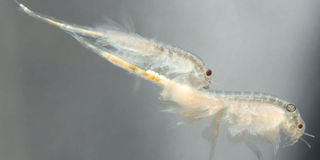Kenya and Tanzania bank on new feed to improve fish production

Artemia biomass can be used to feed older fish or in the formulation of other animal feeds.
What you need to know:
- Researchers say the collaboration between the two countries involves research institutions, universities and farmers.
- This follows the depletion of fish catches in the Indian Ocean and other natural waters.
Kenya and Tanzania plan to adopt Artemia as an alternative fish feed in marine aquaculture.
This follows the depletion of fish catches in the Indian Ocean and other natural waters.
Artemia is a highly nutritious live food ideal for weaning fish and shrimp larvae – rich in omega 3 fatty acids. It is superior to other live feeds in larviculture since the eggs can hatch within 24 hours. Kenya produces around 50kg of processed cysts every month with the potential of producing a tonne monthly.
Artemia biomass can be used to feed older fish or in the formulation of other animal feeds.
Scientists from the Kenya Marine and Fisheries Research Institute (KMFRI) and Tanzania Fisheries Research Institute (Tafiri) said Artemia will improve fish feeds and production in East Africa.
KMFRI director, Prof James Njiru, and a researcher from Tafiri, Dr Imani Kapinga, said the collaboration between the two countries involves research institutions, universities and farmers.
“The highest mortality of young fish is usually at the growing stage due to feeds. But Artemia improves survival rate up to over 90 per cent, so its impact is very positive in terms of growing fish in the region,” said Prof Njiru.
High protein
Kenyan and Tanzanian farmers will be trained on how to produce and process Artemia for their own feeds. “We have Artemia in our salt farms but we do not know how to use it. Artemia is very crucial due to its high protein. Importing Artemia is very expensive especially now because of the pandemic,” said Dr Kapinga, who is also the acting assistant director in the Ministry of Livestock and Fisheries in Dodoma.
Researchers from Maseno University led by Dr Erick Ogello and Morine Mukami of KMFRI and Dr Mary Opiyo are utilising Artemia to promote marine aquaculture.
“Artemia is easily ingestible and digestible to provide the required nutrition for the fish. It has been in the East Coast of Kenya and in Tanzania for over 30 years but we have not been able to sustainably exploit it for aquaculture production,” added Dr Ogello.
Mukami said Kenya was borrowing a leaf from Vietnam who are the leading producers of Artemia globally. Kenya has made strides after KMFRI purchased the first Artemia processing plant in Africa from Vietnam. Six technical staff and scientists have been trained in Vietnam on production of Artemia.



